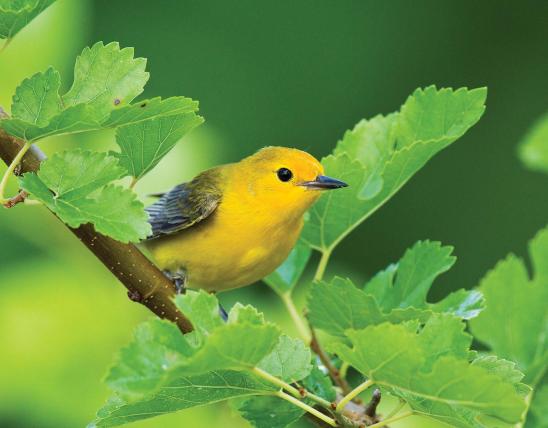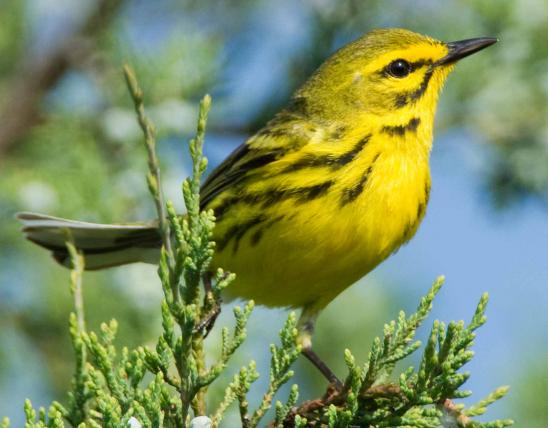
Hooded warbler upperparts are olive green; underparts are yellow. Adult males have a black hood and bib that contrast with the yellow mask over the forehead, eye, and cheek. The black eye stands out on the yellow cheek. The female varies from having no black to having a pattern similar to that of adult male. Tail looks white, seen from below. When spread out and seen from above, white patches of the outer tail feathers are visible. Tail flicking and spreading often reveals the white patches. Song is a loud taWHEAT taWHEAT taWHEATeo. Call is a loud chink.
Length: 5¼ inches.

Mainly in the southeastern third of the state (central Ozarks).
Habitat and Conservation
Forages among dense saplings, giant cane stands, and thickets on north- and east-sloping ravines. This species is very difficult to see in dense foliage. Both hooded and Swainson’s warblers are usually found in similar rich bottomland forests of the lower Ozarks. Swainson’s warblers are usually closely associated with giant cane in forested riparian floodplains. Hooded warblers also nest in this habitat type, but they also nest locally in densely vegetated habitats on moist north- and east-facing slopes farther north in Missouri. Both species are rare and difficult to find unless you visit their specific habitat in the lower Ozark region. Canoeing is one of the best ways to search for them, particularly on the Current, Eleven Point, and Black rivers. Alternatively, you can try looking for them at a streamside park or river crossing, where there is forest and dense understory vegetation.
Food
Forages for insects and spiders in dense saplings, giant cane stands, and thickets on north- and east-sloping ravines. Often seen catching flying insects on the wing.
Status
As a summer resident, uncommon in the central Ozarks, casual elsewhere. As a transient, casual in northern Missouri. In 2010, biologists announced that genetic research had indicated that the American redstart (Setophaga ruticilla) and hooded warbler (which had been called Wilsonia citrina since 1838) were too closely related to be placed in separate genera. Since genus Setophaga had been officially described prior to Wilsonia, it took precedence and the hooded warbler became Setophaga citrina.
Life Cycle
Present in Missouri from mid-April through early September; overwinters mostly along the east coast of Central America and in the West Indies. Cup nests are built low in bushes and are constructed of a variety of dried fine, dried plant materials held together with spider webs. A clutch comprises 3–5 eggs. Hooded warblers can live to be at least 8 years old.
Human Connections
Before DNA testing was available, taxonomists grouped together related organisms based on similarities of anatomy, biochemistry, and other visible, measurable characteristics. But just as DNA clarifies human ancestry, despite traits like hair, eye, and skin color, it is an important tool for discovering the true lineages among other species.
Ecosystem Connections
Like most warblers, this species helps limit insect populations. Brown-headed cowbirds often parasitize them, depositing their eggs into the nests of the warblers. The faster-growing cowbird young usually outcompete the warbler young, with few, if any, of the warbler young surviving. Fragmentation of large forest tracts by human development exposes more warbler nests to cowbirds.




About 350 species of birds are likely to be seen in Missouri, though nearly 400 have been recorded within our borders. Most people know a bird when they see one — it has feathers, wings, and a bill. Birds are warm-blooded, and most species can fly. Many migrate hundreds or thousands of miles. Birds lay hard-shelled eggs (often in a nest), and the parents care for the young. Many communicate with songs and calls.



























